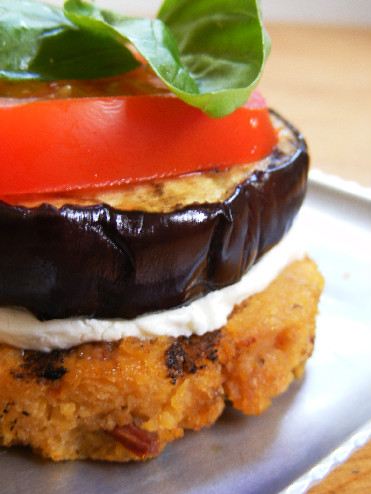Cornmeal: 2 Tomato 2 Cheese Polenta Stack
Wednesday, June 16th, 2010
Now that you know how to make your own polenta chubs, here’s an easy recipe for a polenta stack with two cheeses – Parmesan and goat cheese – and two tomatoes – sundried and fresh.
It’s perfect for summer gatherings or for anytime you want to highlight the fresh bounty from your garden (or the farmer’s market).
But, first a little more about polenta . . .
Although polenta has become noticeably more popular in the U.S., it’s still a mystery to many homecooks. It has yet to go mainstream like so many Italian favorites. I confess that before making my own polenta, I’d really only tried the store-bought chubs. I wasn’t impressed and couldn’t figure out the hype.
But now, I’m hooked. Cornmeal (polenta/grits) is a staple in my refrigerator. Course cornmeal’s versatility is endless – eaten as a simple bowl of mush for breakfast or transformed into decadence with wild mushrooms, rich cheeses, truffles, red sauces, sausages and bacon.
In the recipe here, firm sundried tomato polenta is topped with creamy cheese and roasted vegetables – I used grilled eggplant, but you could substitute or add grilled zucchini or other summer squash, roasted peppers, mushrooms or omit entirely. Next time, I’m making mine with a fat, juicy portobello mushroom.
Enjoy.
Tidbits on Cornmeal:
- Cornmeal is rich in protein but if eaten on a regular basis, it should be combined with milk, butter, cheese or other dairy products so that it becomes a complete food (by adding lysine and tryptophan – two missing amino acids in cor). Add poultry, meat, fish and /or some vegetables as a source of niacin.
- Polenta should taste like corn. Stone ground corn will gradually lose its taste. To maximize flavor and minimize waste, refrigerate cornmeal in a sealed container and use it within two months of purchase.







